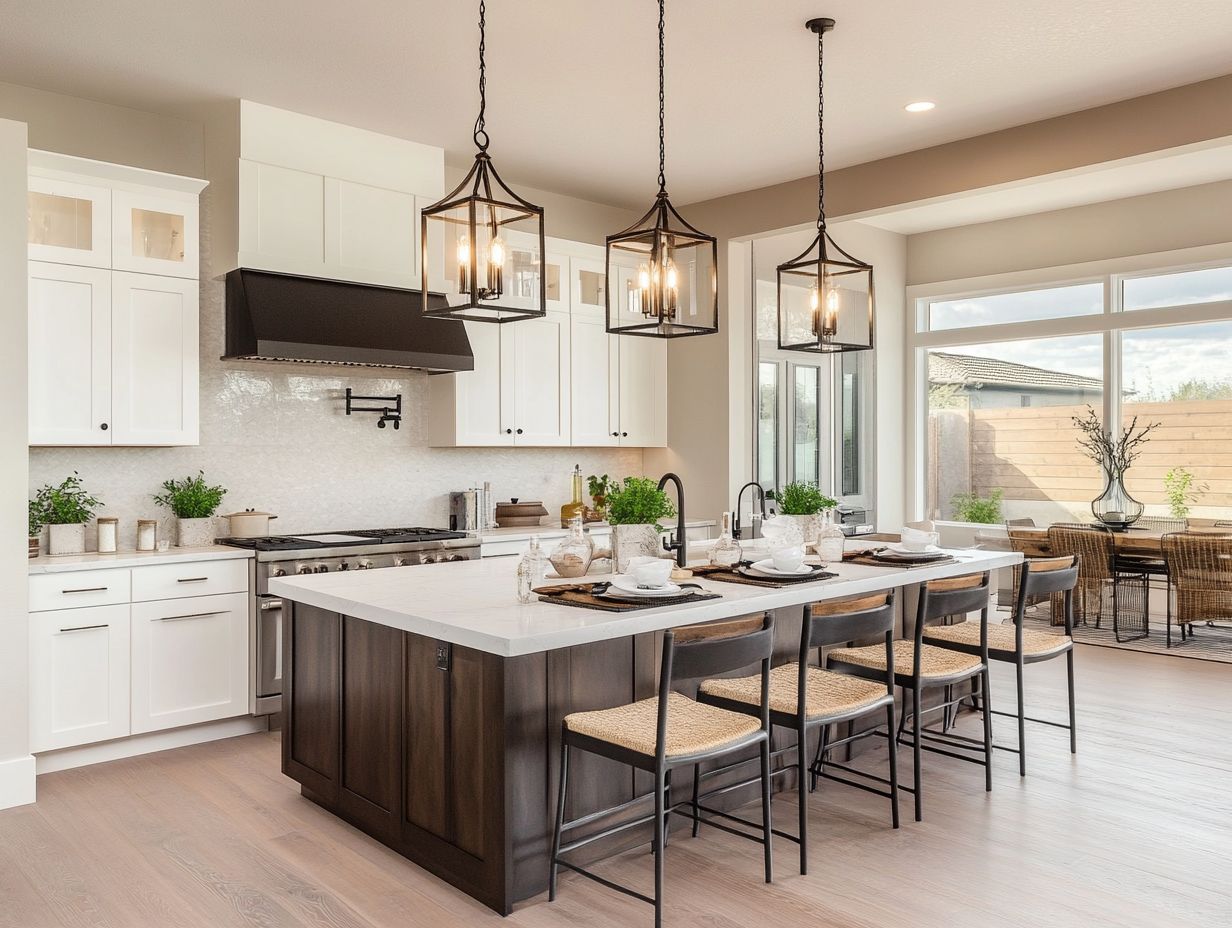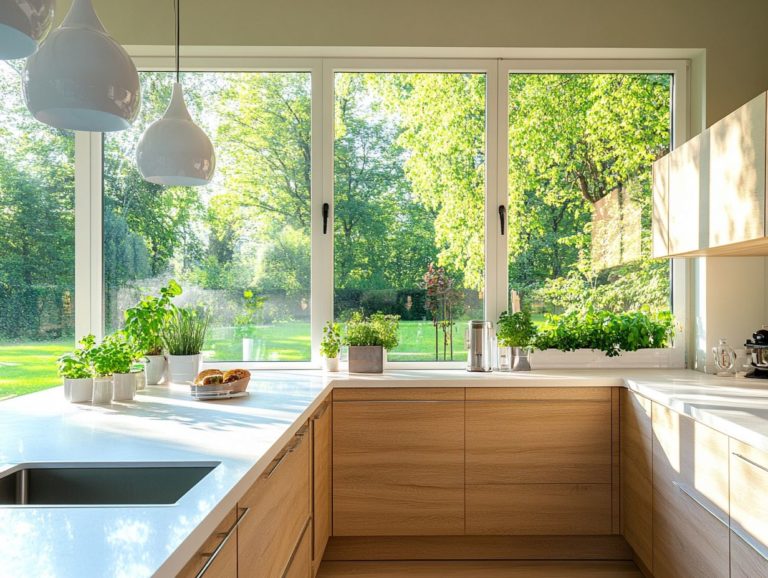5 Essential Kitchen Design Principles
Designing your kitchen goes beyond merely selecting trendy colors or stylish appliances; it’s about crafting a space that works for you.
From functionality to lighting, the right design transforms your kitchen into the heart of your home.
This article explores five essential kitchen design principles that prioritize efficiency and style. Whether you’re remodeling or seeking fresh inspiration, you’ll find practical tips to enhance your kitchen’s layout while avoiding common pitfalls.
Get ready to maximize your space and infuse your personality into one of the most significant areas of your home.
Contents
- Key Takeaways:
- 1. Functionality Comes First
- 2. Consider the Work Triangle
- 3. Maximize Storage Space
- 4. Choose Quality Materials
- 5. Don’t Forget About Lighting
- What Are the Key Elements of a Well-Designed Kitchen?
- Frequently Asked Questions
- What are the 5 essential kitchen design principles?
- How does functionality play a role in kitchen design?
- What is the significance of efficiency in kitchen design?
- Why is aesthetic appeal important in kitchen design?
- How does safety factor into kitchen design?
- What is the role of sustainability in kitchen design?
Key Takeaways:

Functionality should be the top priority in kitchen design. This ensures ease of movement and efficient use of space.
The work triangle, consisting of the sink, stove, and refrigerator, should be carefully considered to optimize workflow.
Maximizing storage space is crucial for creating an organized and clutter-free kitchen.
1. Functionality Comes First
In kitchen design, functionality reigns supreme. It influences every aspect of layout, organization, and usability.
A well-planned kitchen elevates your cooking experience and streamlines meal preparation. This ultimately saves you time and reduces stress.
Smart organization through accessible storage solutions, designated work zones, and a seamless flow between appliances makes a remarkable difference in how you navigate your space.
Design principles that prioritize usability, like the kitchen work triangle, allow for smoother movements between the sink, stove, and refrigerator.
By considering these elements, you can create an inviting cooking area that beautifully combines efficiency with aesthetics, turning daily tasks into enjoyable experiences that spark your creativity.
2. Consider the Work Triangle
The work triangle is a key concept in kitchen design. It connects the stove, sink, and refrigerator to create an efficient cooking environment.
This arrangement fosters a smooth transition from one task to another, minimizing unnecessary movement and reducing the time spent on meal preparation.
Selecting the right appliances is crucial; their size, functionality, and placement can significantly impact how easily you can access them while cooking.
For instance, positioning the refrigerator near the prep area streamlines food preparation, while placing the sink between the stove and refrigerator facilitates quick ingredient transfers.
A well-planned design uses these elements to create a harmonious and productive cooking space tailored for your cooking activities.
3. Maximize Storage Space
Maximizing storage space is essential for a functional kitchen.
Effective organization and thoughtful cabinet selection enhance the usability and accessibility of your essential tools and ingredients.
By integrating innovative storage solutions—like deep drawers, pull-out racks, and versatile shelving units—you can dramatically boost your kitchen’s efficiency.
These options provide ample room for your pots, pans, and pantry items, ensuring every nook is utilized effectively.
Choosing durable materials like plywood or laminate ensures they withstand daily wear and tear, keeping your kitchen functional and visually appealing for years.
This approach to storage streamlines your cooking process, ultimately transforming your kitchen into a more enjoyable and inviting space.
Start using these tips today to transform your kitchen!
We want to hear from you! Share your kitchen design stories in the comments below!
4. Choose Quality Materials

Choosing quality materials is essential for your kitchen design. They shape the aesthetics and durability of your space.
Opting for high-quality materials like granite, quartz, and marble provides a striking visual appeal. These materials withstand the demands of daily use and effortlessly complement various design styles.
By adding texture and timeless elegance, they elevate the entire atmosphere. With minimal upkeep required, these materials are perfect for those who value convenience.
By investing in durable choices, you enhance the long-term value of your renovations. This proves that aesthetics need not compromise practicality.
Ultimately, the harmonious blend of form and function in these finishes creates a kitchen that’s just as enjoyable to use as it is to admire.
5. Don’t Forget About Lighting
Adequate lighting is an essential component of your kitchen design. It improves comfort and how well the kitchen works, all while serving as a key design feature that enhances the overall aesthetic.
Different types of kitchen lighting—ambient, task, and accent—each play a crucial role in creating a warm and inviting space that you love to cook in.
- Ambient lighting provides a warm glow that envelops the entire room, fostering a welcoming atmosphere.
- Task lighting focuses on specific work areas, ensuring that your meal preparation and cooking are both safe and efficient.
- Accent lighting, in contrast, draws attention to architectural features or stunning décor elements, adding visual interest and depth to the space.
By carefully selecting lighting fixtures that marry functionality with style, you can significantly boost usability and organization in your kitchen. This transforms it into a place that is not only efficient but also visually captivating.
What Are the Key Elements of a Well-Designed Kitchen?
A well-designed kitchen reflects your unique needs through a thoughtful integration of essential elements. These include effective workflow, usability, and aesthetics, all working in harmony.
The arrangement of your appliances, counter space, and cabinetry is crucial for optimizing workflow. This ensures that every task you undertake is seamless and efficient.
Usability is enhanced by ergonomic design, allowing you to access all areas of your kitchen comfortably. Ample storage space is equally vital; it minimizes clutter and promotes organization.
Embracing sustainable design practices elevates your kitchen’s visual appeal with natural materials and energy-efficient appliances. It also showcases your commitment to environmental responsibility.
It’s a beautiful reminder that elegance and functionality can indeed coexist in perfect harmony.
How Can One Create a Functional Kitchen Layout?
Creating a functional kitchen layout requires you to think about your cooking needs. A well-planned layout helps improve your cooking flow and efficiency.
Exploring various layout options—like L-shaped, U-shaped, and galley kitchens—allows you to tailor the space to fit your unique cooking style and household requirements.
For instance, an L-shaped kitchen enhances movement, accommodating multiple cooks at once. A U-shaped layout maximizes storage and counter space, making it ideal for larger families.
On the flip side, galley kitchens shine in compact areas, creating an efficient work triangle that prioritizes usability.
By meticulously planning these layouts, you can elevate both functionality and organization in your kitchen. This transforms everyday cooking tasks into enjoyable and stress-free experiences.
What Are Some Common Mistakes to Avoid in Kitchen Design?

Avoiding common mistakes in kitchen design is crucial for ensuring your space is usable and well-organized. Errors in layout can lead to inefficient workflows and a chaotic kitchen environment.
To create a kitchen that truly fulfills its purpose, pay close attention to the spacing between appliances and countertops. This can significantly impact your movement and efficiency while preparing meals.
Not having enough storage often results in clutter, making it difficult to locate tools and ingredients when you need them most. Poor lighting choices can also diminish the ambiance and functionality of the space, leaving certain areas dim and uninviting.
With thoughtful planning and a strategic approach—utilizing built-in cabinets, task lighting, and an open layout—you can transform your kitchen into a practical and enjoyable cooking haven that caters to your individual needs.
How Can One Incorporate Personal Style into Kitchen Design?
Incorporating your personal style into kitchen design is a fantastic opportunity to blend functionality with aesthetics. It allows you to express your unique tastes through personalized design choices that enhance your kitchen environment.
By carefully selecting color schemes that resonate with your personality—whether you lean towards bold hues or subtle tones—you can create a space that feels authentically yours. Choosing a design theme, like rustic, modern, or eclectic, contributes to a cohesive look that truly reflects your preferences.
The importance of quality materials cannot be overstated; premium finishes and durable elements elevate the visual appeal and fulfill practical needs.
This thoughtful balance ensures that your kitchen transforms from merely a culinary workspace into a warm gathering place that aligns perfectly with your lifestyle, inspiring creativity every time you step inside.
What Are the Latest Trends in Kitchen Design?
The latest trends in kitchen design focus on energy efficiency and sustainable practices. They emphasize integrating technology and innovative elements that promote both eco-friendliness and functionality.
Homeowners and designers are increasingly captivated by smart appliances, which simplify your cooking experience and lower energy consumption, showcasing a true commitment to sustainability.
The use of sustainable materials, like bamboo and recycled metals, is gaining momentum, showcasing an artistic approach to environmental responsibility.
Open layouts continue to reign supreme, facilitating better flow and interaction between spaces while enhancing usability and creating a visually appealing environment.
Together, these elements embody a modern approach to kitchen design that balances practicality with a conscious effort to minimize your carbon footprint.
How Can One Design a Kitchen on a Budget?
Designing a kitchen on a budget is entirely possible when you employ strategic planning and cost-effective solutions that emphasize durability and functionality, all while maintaining a sense of style during your renovation journey.
With thoughtful consideration and a dash of creativity, you can transform your cooking space into an inviting and efficient haven. A fantastic starting point is to dive into DIY projects that let you infuse your personal touch, whether it’s refinishing cabinets or crafting custom shelves from reclaimed wood.
Repurposing items—like vintage furniture or decorative jars for storage—can add unique character while keeping costs in check.
When shopping for appliances and finishes, always look for sales, explore gently used options, and focus on essentials that enhance both the enjoyment and organization of your kitchen space.
Frequently Asked Questions

What are the 5 essential kitchen design principles?
Here are the five key principles to make your kitchen amazing: functionality, efficiency, aesthetic appeal, safety, and sustainability.
Ready to start your kitchen transformation? Let’s get started today!
How does functionality play a role in kitchen design?
Functionality is key in kitchen design. It ensures efficient and practical use of the space.
What is the significance of efficiency in kitchen design?
Efficiency optimizes the use of space, time, and resources. This involves placing appliances wisely and creating effective storage solutions.
Why is aesthetic appeal important in kitchen design?
Aesthetic appeal makes the kitchen inviting. Choosing the right colors, materials, and finishes creates a cohesive look.
How does safety factor into kitchen design?
Safety is essential to prevent hazards. This includes proper appliance placement and using non-slip flooring.
What is the role of sustainability in kitchen design?
Sustainability is vital for reducing environmental impact. Use eco-friendly materials and energy-efficient appliances wherever possible.





